The Ultimate Guide to Local SEO for Small Businesses (2025)
Getting found by local customers online isn’t some magic trick, it’s about making sure your business shows up when people nearby are searching for...
Got a question, or need help with something?
A member of the LoudLocal team is on hand to help you.
The Brickyard, Unit 2, Queen's Rd, Kenilworth, Warwickshire, CV8 1JQ
5 Merchant Square, Paddington, London, W2 1AY
16 min read
Taya Grao-Randall
:
Oct 30, 2025 4:26:15 PM
Running a trades business takes a lot of time and energy. You’re busy on site, chasing quotes, and keeping customers happy. But while you’re focused on the work, one of the simplest ways to bring in new jobs could be sitting right in front of you online: your website.
These days, people don’t reach for a phone book or wait for a recommendation. They pull out their phone, search for “electrician near me,” “plumber in Leeds,” or “local carpenter,” and pick the businesses they find. If your website isn’t there or doesn’t look professional, those jobs will go to your competitors.
A good website does more than just exist online. It shows that you are professional, reliable, and ready to take on the work. It gives potential customers the confidence to pick up the phone without even meeting you. Photos of your work, clear service descriptions, and visible contact information all help people trust you before you even step foot on site.
This guide will walk you through everything a trades website needs. We’ll cover core features, design, local SEO, content that converts, trust signals, common mistakes, and practical steps to get your website working for your business. By the end, you’ll know exactly how to build a site that attracts local customers, builds trust, and helps your business grow. Let's get started!
Think about how most people find a tradesperson today. A boiler breaks, the lights stop working, or the garden fence finally falls apart. They grab their phone, type in “plumber near me” or “landscaper in Leeds,” and start clicking through results. If your business does not appear or your website looks old and unprofessional, they will move on to the next name.

Your website is often the first impression someone has of your business. A clear, modern, and easy-to-use site signals reliability and professionalism even before a conversation starts. If your site is confusing, slow, or outdated, potential customers may assume your work is the same.
A strong website acts like a shop window. It shows off your best work, explains your services, and gives customers the confidence to choose you over a competitor. They do not want to hunt for your phone number or guess whether you cover their area. Putting that information front and centre makes life easier for your customers and increases the chances they will pick up the phone.
Trust is crucial in trades. People are inviting you into their home, garden, or business and need to feel confident that you will do a proper job. Your website can help build that trust before you even meet. Photos of real jobs, customer reviews, and visible accreditations show potential clients that you are competent and reliable. These elements provide multiple reasons for someone to call you instead of your competitor.
A well-designed website is not just about appearance. It is about functionality, clarity, and building confidence. Every feature, from service descriptions to contact forms, works together to make your business approachable and trustworthy. When done right, your website becomes one of your most powerful tools for attracting local customers and generating leads consistently.
Visitors come to your website because they have a problem they need solved. They want answers quickly about what you do, where you work, and how to get in touch. If your site does not provide that clearly, they will move on to someone else.
Your phone number should be visible at the top of every page. Add a clear “Call Now” button for mobile users and make sure your contact form is easy to fill in. If someone has to search for your details, they will leave and call the next tradesperson instead. Think of it like leaving your van parked on the street with no phone number on it. People will just walk past.
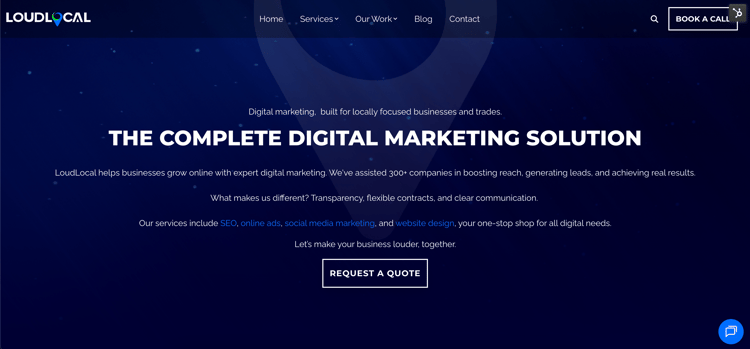 Our homepage has clear CTAs to book a call and request a quote, making it easy for potential clients to contact us
Our homepage has clear CTAs to book a call and request a quote, making it easy for potential clients to contact us
Do not assume customers understand trade jargon. Explain what each service includes in plain English. For example, a carpenter might think “joinery” covers everything, but a customer might not realise that includes fitting doors, building wardrobes, or creating custom shelves. Creating a page for each main service helps people find exactly what they are looking for. A visitor searching for “fitted wardrobes Birmingham” should land directly on a page that answers their query.
Trades are built on trust. Customers want to know who is turning up at their door. A short 'About' page with a photo of you or your team, a few lines about your experience, and a brief explanation of why you started the business goes a long way. You do not need to write a long essay; a few honest lines make your business feel more approachable.
Anyone can say they are reliable, but customers want evidence. Include photos of completed projects, before-and-after shots, and any qualifications or accreditations. Customer reviews and testimonials also build credibility. For example, before-and-after images of a bathroom refit or garden deck demonstrate your skills far better than words alone.
One of the biggest mistakes trade businesses make is not saying clearly where they work. A customer searching for “electrician near Bristol” will not call if your website does not mention Bristol. Add a list of areas you cover or include a simple map. This helps potential customers know you are local and allows Google to show your business in relevant local searches.
 This is the Google Local Pack - if you include your location on your website, you're more likely to end up in the top search results here
This is the Google Local Pack - if you include your location on your website, you're more likely to end up in the top search results here
Every page should guide visitors toward the next step. Use simple phrases like “Call for a free quote,” “Send a message now,” or “Book a site visit today.” Place these buttons in multiple visible locations, including the top of the page, alongside service descriptions, and at the bottom of pages. The easier it is to act, the more likely someone will contact you.
When these core features are done right, your website stops being just another online page. It becomes a powerful tool that answers questions, builds trust, and encourages visitors to pick up the phone. This is how your website can start working for you, even while you are on-site or busy with another job.
Once the core features of your website are in place, the design brings everything together. Good design is not about flashy graphics or complicated animations. It is about making your site clear, easy to use, and professional. A well-designed site reassures customers and makes it easier for them to get in touch.
Visitors are looking for answers quickly. A cluttered page with too many colours, large blocks of text, or confusing menus will push people away. Stick to a clean layout with clear headings, short paragraphs, and straightforward navigation. Think of your website like your work van: tidy, organised, and easy to understand.
Photos are one of the most effective ways to showcase your work. A before-and-after shot of a bathroom refit, new fencing, or a rewired kitchen shows exactly what you can do. Avoid generic stock images of smiling builders. Customers want to see real jobs you have completed. Even simple photos taken on your phone can look genuine and build trust.
Most people searching for trades services are on their phones. They might be standing in their kitchen looking at a leaking pipe or outside by a broken gate. If your site is not mobile-friendly, buttons may be too small, text may be hard to read, and visitors will leave in frustration. Mobile-friendly design includes big tappable buttons, readable text, and layouts that work without pinching or zooming.
%20(1).png?width=750&height=750&name=CS%20mockups%20(11)%20(1).png) Your website should be accessible - no matter what device it's being viewed on
Your website should be accessible - no matter what device it's being viewed on
Visitors will not wait around for a slow website. If pages take more than a few seconds to load, they will hit the back button and call someone else. Keep your site fast by optimising images, avoiding unnecessary plugins, and limiting extra features that slow the site down. First impressions matter online just as much as on-site.
A website that looks disorganised or inconsistent can make people doubt your reliability. Use the same colours, fonts, and style across every page. If your van, business cards, and uniforms are navy and green, use those colours on your website too. Consistency shows that your business is professional and organised.
When you follow these design principles, your website becomes more than just attractive. It guides visitors smoothly from browsing to contacting you. It shows that your business is professional, reliable, and ready to get the job done. Every detail, from the layout to the visuals, should make it easy for customers to trust you and take action.
Your website is not just a place to list services. It is also a tool to show customers why they should trust you. For trades, trust is everything. People are letting you into their home, garden, or business, and they need to feel confident you will do the job properly.
Any qualifications or trade body memberships should be visible. If you are Gas Safe registered, a member of Checkatrade, or insured, display those logos. Customers may see these as simple requirements, but to them, they are proof that they can trust you. Even showing proof of insurance helps reassure clients.
Reviews are one of your strongest tools. Visitors may be unsure about contacting you, but reading that other local customers had a positive experience removes doubt. Include reviews on your website as well as on Google or Facebook. Adding the customer’s first name and town makes them feel genuine and local.
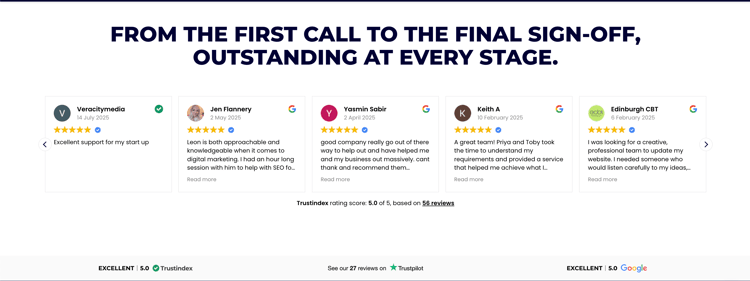 We use a tool to showcase our reviews on our site
We use a tool to showcase our reviews on our site
Sometimes a photo alone is not enough. Short case studies work well. Describe what the customer needed, what you did, and the result. For example: “Mrs Taylor in Coventry wanted a new patio. We cleared the old one, laid new slabs, and built a raised flower bed. She was so pleased she booked us to do her driveway as well.” These stories help visitors picture you solving their own problem.
At the end of the day, customers want to hire a person, not a faceless business. A friendly photo of you or your team, even taken on site with your phone, makes a big difference. It shows that there is a real person behind the name and helps customers feel more comfortable calling.
When you combine consistent branding with visible trust signals, your website becomes more than an online advertisement. It becomes proof that your business is professional, reliable, and the right choice for the job.
Most trades businesses get the majority of their work from nearby customers. Your website needs to make it very clear where you operate so both potential customers and Google know who to call. Local SEO helps your business appear when someone searches for services in your area, such as “electrician in Leeds” or “gardener near me.”
Service areas should be easy to find. A simple list of towns, postcodes, or an embedded map lets visitors see immediately if you cover their area. For example, if you work across Manchester, Salford, and Stockport, make that clear on your homepage and service pages. Without this information, potential customers may assume you are too far away and call a competitor instead.
When describing your services, mention the locations you serve in plain language. Instead of saying “We fit kitchens,” write “We fit kitchens in Coventry and the surrounding area.” This helps Google match your business with local searches so nearby customers find you first.
Your Google Business Profile is a key tool for local search. Include a visible link on your website so visitors can check your reviews, opening hours, and contact details. Encourage customers to leave reviews and keep the profile updated. A well-maintained profile increases your chances of appearing in Google Maps and at the top of local search results.

Google Business Profile is the way to update what customers see from your business on Google
Adding a Google Map showing your office or main location makes it easier for customers to plan a visit and builds trust. When people see that you are based locally, they are more likely to contact you than a business across the city.
If your hours, services, or locations change, update your website immediately. Out-of-date information can frustrate customers and hurt search rankings. For example, if someone searches for an emergency plumber on a Saturday and sees the wrong hours, you could lose that job. Regular updates also signal to Google that your site is active, which improves local SEO.
When setting up local SEO, imagine someone searching for your service. They want quick answers about whether you can do the job, where you operate, and how to get in touch. Make this information easy to find. The simpler it is, the more likely someone will contact you instead of scrolling past your site.
By building these local SEO basics into your website, you make it easy for nearby customers to find you, understand your services, and trust that you are the right choice. When someone needs a plumber, carpenter, or electrician close to home, your business should be the first one they see. Optimising your site for user experience actually helps SEO, further increasing the chances of potential customers finding you on Google.
Your website is not just a digital brochure. Its main job is to turn visitors into customers. Every page should answer the questions people are asking and make it easy for them to take action. If someone lands on your site and cannot find what they need quickly, they will move on to a competitor.
Each main service should have its own dedicated page. For example, a carpenter might have separate pages for fitted wardrobes, decking, and shelving. Explain clearly what each service includes, how you work, and what customers can expect. Include photos of past jobs with short captions such as “Decking in a Coventry garden completed in one day.” Someone searching for “decking in Leeds” should land directly on a page that answers their query.
A call to action tells visitors exactly what to do next. Use phrases like “Call for a free quote,” “Send a message now,” or “Book a site visit today.” Place buttons in obvious locations such as the top of the page, at the end of service descriptions, and alongside testimonials. The easier it is to act, the more likely someone will contact you.
Even if you are busy on site, a small blog or advice section adds real value. Posts like “5 Tips to Keep Your Boiler Working in Winter” or “How to Choose the Right Fence for Your Garden” show that you know your trade and care about your customers. These posts can also help your site appear in Google searches for people looking for advice, not just services. Providing helpful content increases trust and makes people more likely to call when they need a job done.
Avoid technical jargon that only someone in your trade would understand. Write as if you are talking to a customer who knows nothing about your job. For example, instead of “We provide bespoke joinery solutions,” say “We make and fit custom shelves, doors, and cabinets to suit your home.” Easy-to-read text keeps visitors engaged and more likely to reach out.
Think about what sets your business apart. Do you turn up on time, offer emergency call-outs, or provide a written guarantee? Make these points clear across your website, on service pages, and alongside testimonials. Small details can make the difference between a customer calling you or a competitor. For example, a family searching for an urgent boiler repair will prefer a tradesperson who advertises same-day call-outs.
Complicated enquiry forms put people off. Ask only for essential information such as name, phone number, email, and the service needed. Make the form easy to spot and quick to complete. The simpler it is for someone to reach you, the more likely they are to do so.
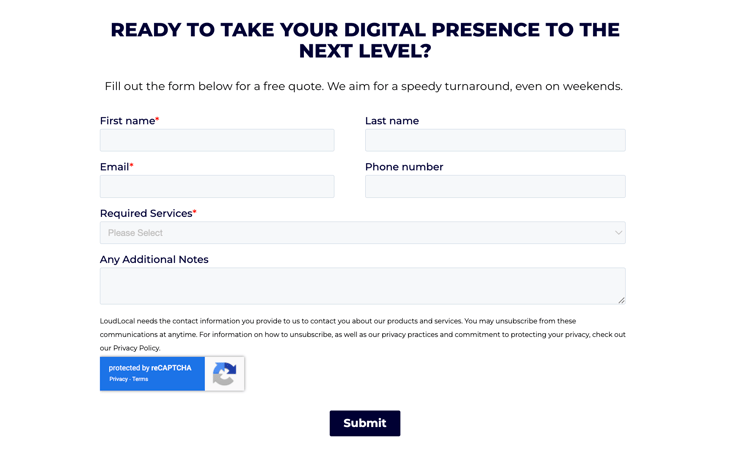 Simpler forms = more likely that customers will contact you
Simpler forms = more likely that customers will contact you
Images, icons, and headings help break up text and make your site easier to scan. Photos of your team at work, diagrams of typical projects, or simple icons highlighting services guide visitors through the page. This keeps them engaged and shows clearly what you do and how to get in touch.
A website that converts is one that guides a visitor smoothly from browsing to contacting you. By focusing on clear services, strong calls to action, helpful content, customer-friendly language, and simple contact options, you make it as easy as possible for someone to choose your business over others. Every detail, from a photo caption to a simple button, should encourage the next step.
Even a website with the right features can struggle if it makes basic mistakes. Avoiding these common traps can make the difference between a website that generates work and one that sits online unnoticed.
Some tradespeople bury their phone number or enquiry form at the bottom of the page. Customers do not want to hunt for your details, especially if they have an urgent problem. Make your phone number and a call-to-action button visible at the top of every page. Consider a sticky header that stays in view as visitors scroll. A simple “Call Now” button ensures customers can contact you immediately.
Blurry or generic stock photos make your business look unprofessional. Customers want proof of your work. Take clear, well-lit photos of your projects. Show before-and-after shots wherever possible. For example, a newly fitted kitchen or a restored garden deck demonstrates your skills and helps visitors visualise what you can do for them.
Long paragraphs full of technical language can be intimidating. Most visitors skim pages for key information. Break up text with headings, bullet points, and images. Keep paragraphs short. For example, instead of a long essay about your carpentry experience, provide a few concise paragraphs, a photo of a recent project, and a clear call-to-action button.
Most people searching for trades are on their phones. If your site is not mobile-friendly, buttons may be too small, text may be hard to read, and pages may load slowly. Mobile-first design ensures visitors can navigate easily, read your content, and contact you, even on a small screen.
Out-of-date hours, services, or pricing frustrate potential customers. If someone visits or calls expecting one thing and finds another, you could lose the job before it even starts. Keep your website and Google Business Profile updated with new services, changed hours, or additional service areas. An active site signals reliability and professionalism.
A beautiful website is useless if no one can find it. Include local keywords, service pages, and location details so customers searching for trades in your area can discover you. For example, a local plumber should mention the towns or neighbourhoods they cover. These details help Google show your business to the right people at the right time.
Visitors need clear instructions on what to do next. Without visible contact options, many will leave without taking action. Use simple, direct language like “Call for a free quote today” or “Send a quick message.” Place buttons in visible spots, such as the top of the page, alongside service descriptions, and at the bottom of pages.
Customers are cautious when hiring tradespeople. If there are no reviews, testimonials, photos of completed work, or visible accreditations, visitors may doubt your reliability. Include these signals to reassure potential clients and give them reasons to pick up the phone.
Avoiding these mistakes makes your website a real asset. It becomes a tool that builds trust, attracts enquiries, and converts casual visitors into paying customers. A clear, professional, and easy-to-use website puts you ahead of competitors who have neglected these basics.
Building a website for your trades business is more complicated than it looks. It is not just about creating a page that looks nice. Your site needs to be fast, mobile-friendly, easy to navigate, optimised for search engines, and set up to convert visitors into customers. If any of these areas are done poorly, your website can actually harm your business by driving potential clients away.
Platforms like Wix, Squarespace, and Weebly allow you to create a website without coding. They include templates and drag-and-drop features, which can be tempting for a DIY approach. In the short term, you can get a simple site online quickly. However, these builders have limitations. Customisation is often restricted, advanced SEO options are limited, and the site may not scale as your business grows. Over time, you might spend extra to fix issues or rebuild the site entirely.
WordPress offers more flexibility than most website builders, with thousands of themes and plugins available. It allows trade businesses to create service pages, galleries, contact forms, and to integrate reviews. WordPress is complex and requires ongoing maintenance, updates, and security management. Without experience, mistakes can slow your site, harm search rankings, or leave it vulnerable to hackers.
The safest and most effective approach is to hire a professional web designer. They can build a site that looks polished, functions properly, and is designed to attract and convert customers. A professional handles all the technical details of web design, including fast hosting, mobile responsiveness, SEO setup, and secure forms. They can also make the site easy to maintain over time, ensuring it continues to work as your business grows.
Think of it like hiring a skilled tradesperson for your own business. Doing it yourself might save money initially, but choosing the right digital marketing agency to professionally build your website is an investment. It pays off with more leads, better visibility, and fewer headaches in the long term.
Websites for trades businesses are complicated projects. They need more than just a “nice look” to succeed. If your budget allows, it is almost always better to invest in a professional who can do it right from the start. In the long term, this approach will save time, money, and stress while giving your business a strong online foundation to grow from.
Building a website that works for your trades business is a big project, but breaking it into steps makes it manageable. These practical actions will help get your site live and start attracting customers.
Define your goals
Decide what you want your website to achieve. Are you aiming for more calls, enquiries through a form, or showcasing past projects to build trust? For example, a plumber might focus on same-day call-outs and emergency services, while a carpenter may want to highlight custom furniture projects. Clear goals guide the structure and content of your site.
Plan your pages and content
Make a list of the essential pages your site needs. At minimum, this should include a homepage, service pages, an About page, a contact page, and a gallery or portfolio. Consider the questions customers will ask and make sure the content answers them. Include photos, reviews, and clear contact options.
Choose a professional to build your site
If your budget allows, hire a professional web designer. A skilled designer ensures your website is mobile-friendly, fast, easy to navigate, and optimised for local SEO. They can set up forms, galleries, and trust signals correctly so your site is ready to convert visitors into customers. Think of it as hiring a specialist to do the job properly rather than risking mistakes by doing it yourself.
Optimise for local search
Make your service areas clear, include relevant local keywords in your content, and link to your Google Business Profile. Embed a map so customers can see where you operate. Keep this information up to date so your website provides accurate details to both customers and search engines.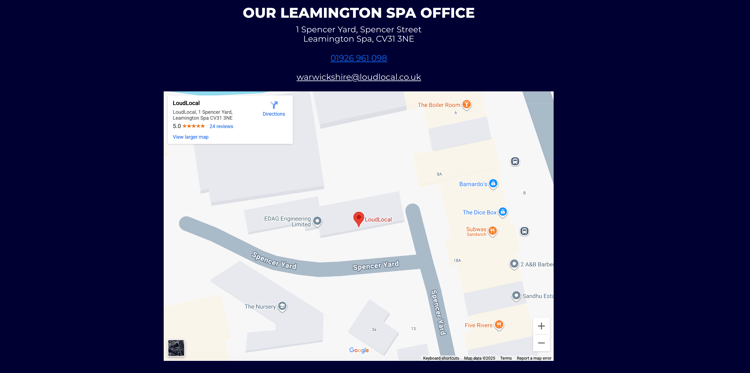
Embed a map on your site to show Google and your customers CLEARLY where you're based
Include calls to action on every page
Every page should guide visitors to take the next step. Use simple instructions such as “Call for a free quote” or “Send a message today.” Place buttons in visible locations at the top of the page, alongside service descriptions, and at the bottom of each page. The easier it is for customers to act, the more likely they are to contact you.
Review and update regularly
Your website is not a one-time project. Regularly update content, photos, services, and opening hours. Add new testimonials and showcase recent work. A site that is maintained and kept current signals professionalism and reliability while improving visibility in search results.
Monitor and improve
Use simple tools to track how visitors interact with your site. See which pages get the most views and where visitors leave. This information helps you make improvements over time, making your site even more effective at generating enquiries and building trust.
Taking these steps ensures your website is more than an online presence. It becomes a tool that attracts local customers, builds trust, and makes it simple for people to contact you. Done right, your website can generate leads consistently and give your trade a competitive edge for years.
A strong website is one of the most powerful tools a trades business can have. It does more than exist online. It shows customers what you do, proves that you are trustworthy, and makes it easy for people to contact you. When your website is well-designed, clear, and focused on your local area, it works hard for your business every day, even while you are on a job.
Building a website that performs takes planning, attention to detail, and the right skills. While DIY options exist, investing in a professional designer ensures your site is fast, mobile-friendly, optimised for search engines, and set up to convert visitors into customers. This is a long-term investment that pays off with more leads, better visibility, and a stronger reputation in your local area.
By focusing on clear services, strong calls to action, trust signals, and local search, your website becomes more than just an online presence. It becomes a tool that attracts and wins customers. Taking the time to get it right will ensure your online presence supports your business growth for years to come.
If you enjoyed this blog, be sure to check out our previous one: SEO for Trades: The Ultimate Guide To Grow Your Business (2025). We post blogs regularly, so why not bookmark? If you're looking for website support or have any questions, consider booking a call with a member of our team. We are happy to help.
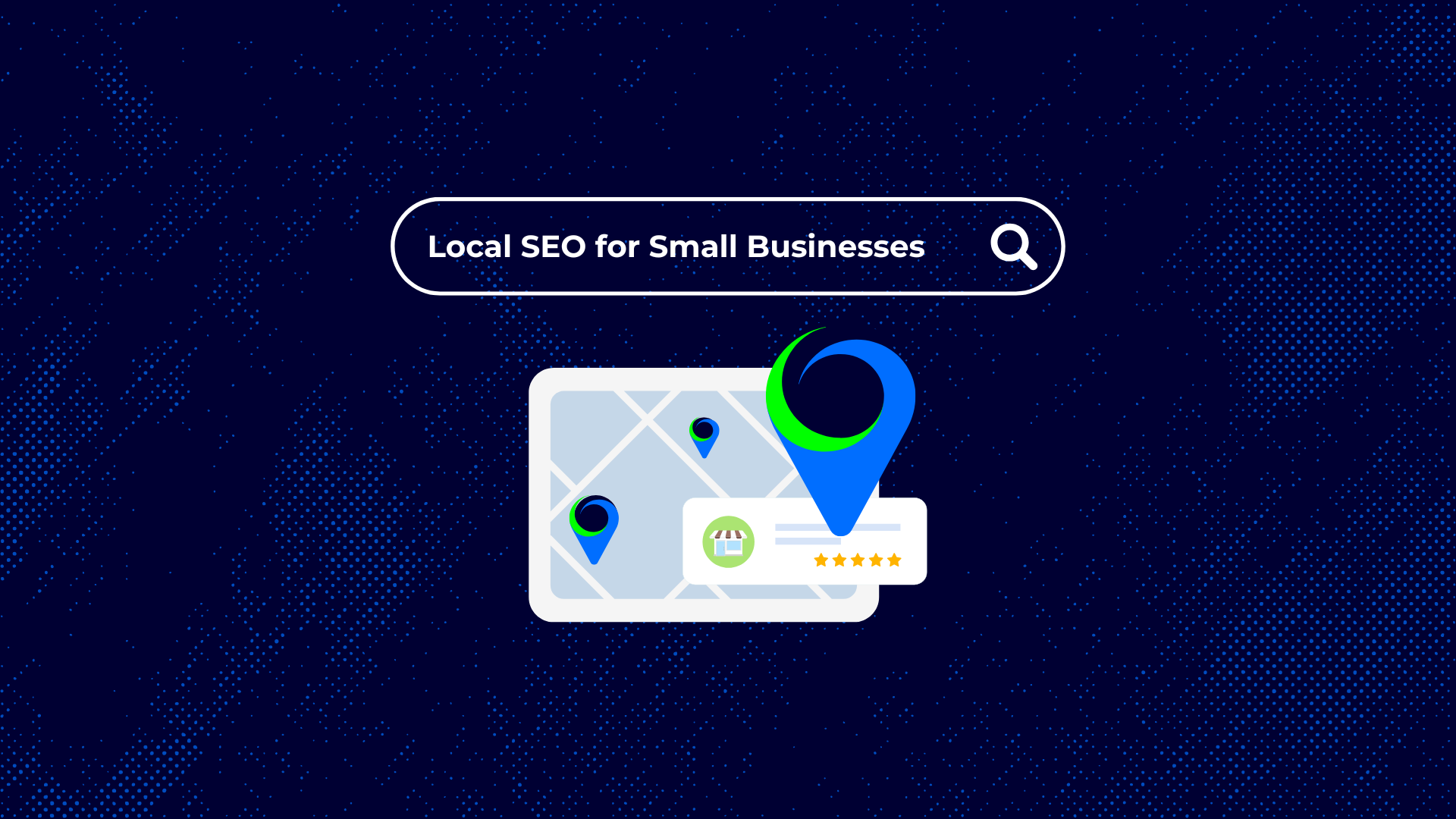
Getting found by local customers online isn’t some magic trick, it’s about making sure your business shows up when people nearby are searching for...

Running a small business is a full-time job in itself, and finding time for social media can feel like an extra task on the list. But here’s the...

Running a trades business takes a lot of time and energy. You’re busy on site, chasing quotes, and keeping customers happy. But while you’re focused...
First Things First - What is Bounce Rate? Bounce rate is a commonly used metric to determine whether your site "holds up" so to speak. When a user...

As long-standing Wix partners and having extensive experience with all the Wix platforms, we were excited to hear about the launch of the new Wix...

A good digital marketing agency can make a massive difference to your business - bringing in more enquiries, boosting your online presence, and...